Jason Maloney reviews
A Career Of Progress & An Eye For Detail
It’s been 15 years since the New York singer-songwriter emerged on the music scene with her debut self-titled album, a time which saw her first two albums achieve significant commercial success, followed by a critical and artistic reappraisal during the 1990s. Often misunderstood, her wry humour and considered (some would say aloof) air has at last been appreciated and acknowledged on a wide scale.
Suzanne Vega is arguably the most consistently excellent recording artist (who does not date back to the late 60s or early 70s) with a sizeable body of work….five studio albums and one Best Of collection so far. Some 58 original recordings populate these albums, and even by the strictest criteria, there are few – if any – weak moments to be found anywhere. In an age where quality control and brevity are becoming a dying breed, every new album is a concise set of coherent ideas and arrangements lasting approximately 40 minutes.
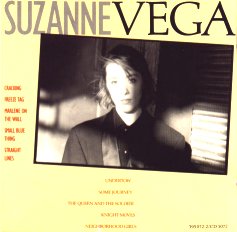
Released in the autumn of 1985, “Suzanne Vega” was a slow-burner…….word-of-mouth spread via live performances and was then followed by the all-important first hit single from the album, “Marlene On The Wall”. Reaching # 21 on the UK Singles Chart in April 1986, it sounded quite unlike any of the records occupying the other 39 positions on the Top 40. Ironically, this very difference – and the clipped, insistent yet strangely distant feel of the track – proved hard for me to love at first.
It really wasn’t until the very end of that year that I really became an admirer of her music. The album remained on the UK charts all through the summer, buoyed by a second Top 30 hit with “Left Of Center”, featured in the John Hughes teen movie Pretty In Pink but not included on “Suzanne Vega” itself. I’d gotten the Pretty In Pink soundtrack (mainly for the OMD and New Order tracks, I have to admit!), but Left Of Center must have grown on me as well because by the release of the Gypsy single in November ’86 I was more receptive and appreciative of what she was doing musically and lyrically. “Small Blue Thing” was her other single release during the year, reaching # 65 on the charts.
It took a late-night TV broadcast of a show from her 1986 tour for me to become completely hooked that December. I went and bought the SV album the next day, and have never looked back since.
Much has changed – or rather evolved – in her music and lyrical outlook since the debut record, but it has stood the test of time admirably well. Everything is already in place, creating a very finely realised vision. Essentially just Vega’s voice and acoustic guitar, occasionally fleshed out with synths and drums, the Song is always centre-stage….allied to intelligent, perceptive and rhythmical lyrics that are clear and precise.
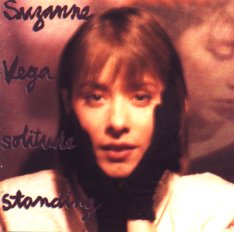
April 1987 saw the release of album number two – “Solitude Standing”. The steady success of the first record had created a considerable demand, and only the might of Curiosity Killed The Cat (at the time the most popular teen pop group in the UK) kept Solitude Standing from the # 1 spot. This achievement was all the more remarkable since there had been no hit single prior to its arrival…Gypsy had stalled outside the Top 75 the previous winter.
Judging by what I could glean from the UK press and from the reactions of people I knew at the time, up until 99.9F there seemed to be a common (mis)conception of Suzanne Vega. Introverted, wordy, humourless folkie. One of the leading UK music magazines even headed their review of Solitude Standing with the word “Depressing” in large bold type. OK, so it wasn’t bouncy pop music, but depressing? No matter. I loved that album dearly, and still do. The spacious sound and feel of it still has a wonderfully cleansing quality to this day.
Taking the blueprint of “Suzanne Vega”, Solitude.. expanded its musical horizons and featured more instrumentation than before. The acapella “Tom’s Diner” – a live staple throughout her live shows – kicked off the album in memorable fashion, coaxing the listener into a world of overheard conversations and coolly observed characters.
It was also the home of probably her best-known song, “Luka”. Issued as a single in the summer of 1987, it quickly became not only another Top 30 UK hit, but went to # 3 on the US Billboard Hot 100. In typical Vega fashion, it blends a lyric about child abuse with the prettiest melody and most infectious arrangement she’s ever written.
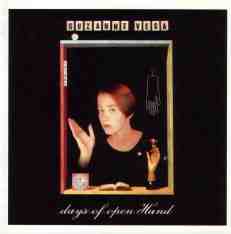
1990’s Days Of Open Hand was more of the same only even further refined. I gather Vega herself regards it with hindsight as a little too “worked-on”. There is certainly a case to be made that the album was perhaps trapping her in an artistic cul-de-sac, though it was a beautifully crafted piece of work.
Perhaps some of the momentum had been lost during the 3 year gap between albums, or the musical climate had simply altered significantly in that time. Though it entered the UK charts at # 7, it disappeared with almost indecent haste. “Book Of Dreams” was a delightfully commercial single, yet it too underachieved, peaking at # 66. Of all Suzanne Vega’s albums, this is the one that largely gets forgotten about, yet if anything its qualities have become clearer with the passing of time. The subsequent sea-change in direction can be traced back to several tracks on Days Of Open Hand. There are signs of what was to follow in the montage of sounds and slightly woozy arrangements of songs like “Institution Green”, “Predictions”, “Big Space” and “Rusted Pipe”. The lyrics, too, were branching out from linear storylines and ruminations, into a whole other realm of imagery and word-association.
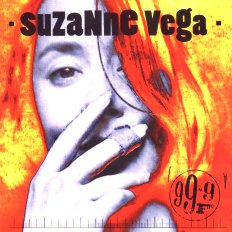
Her ability to evoke dream-like worlds on the first two albums had already slightly mutated on DoOH, but with 99.9F she went even further into that ethereal zone. The title track and “Blood Makes Noise” are obvious examples, but a sense of “something not quite right” infused the entire album. Even the musical arrangements deviated from the concise songs and slightly polished production of the previous records. Though she was still the master (or should it be mistress?) of economy and precision, the music had become prone to off kilter moments and unexpected sounds technically known as *weird bits*.
It’s entirely possible that 99.9F was simply a natural progression from Days Of Open Hand, but the DNA reworking of Toms Diner in 1990 may have had some influence. Placing the half-sung, half-spoken lyrics to a repetitive, hypnotic dance beat and focusing on the “da da da-da, da da-da da” refrain more than the original did, the track was massively popular on both sides of the Atlantic. I liken this phase in SV’s career with that of Everything But The Girl’s development from Amplified Heart to Walking Wounded via Todd Terry’s remix of Missing.
In their case, it’s also quite probable that the direction their music was taking would have still brought them to Walking Wounded even without the danced-up hit mix of Missing. Sometimes, however, I wonder whether too much was/is made of the “change” that 99.9F represented. There are still a handful of “old-style” Suzanne Vega tracks on the album. The main difference with 99.9F, compared to its predecessors, is the emergence of a greater playfulness both lyrically and musically.
Now, she surely didn’t suddenly pop into her local hospital and get a sense of humour implant. It was always there, because during the one and only show of hers I have so far had the pleasure of attending back in 1987, her between-song banter was full of that same undercurrent of dry humour and mischief. I’m also not convinced that the only discernible difference or progression from the first 3 albums to 99.9F is in the music.
What always strikes me is that the majority of lyrics on 99.9F have a significantly more daring and humourous tone, and a greater sense of that “something not quite right”. Only “In Liverpool”, “Bad Wisdom” and the closing couple of tracks on 99.9F have anything like that older Vega feel to them lyrically. It’s the tone to the lyrics of “As Girls Go”, “Blood Makes Noise”, “If You Were In My Movie”, “Fat Man & The Dancing Girl” – and even the title track itself – that distinguish 99.9F. In fact, in 1992 when 99.9F came out, I was going through one of the most severe phases of my illness and became entranced by the album’s feverish, almost hallucinatory feel. Every song had an air of something awry, often in a mental or physical sense. To read Vega’s own thoughts upon this aspect of the album in her book of collected writing called “The Passionate Eye” (see below), it seems this was precisely the intent and also a reason for the album’s title.
In conclusion, I don’t believe it was such a sudden shift at all, as with each album she was moving closer to 99.9F. To suggest that the first album plus a 99.9F-style production and arrangement would produce a similar record just doesn’t add up.
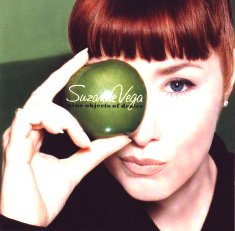
Then you have “Nine Ojects Of Desire”, of course, which took things to their next logical stage. Released in 1996, but delayed until April 1997 in the UK, it was a distinctly “sexier” piece of work than 99.9F, and thus added another element to her style. The sensual subtext and overtones lent the album a warmer, more human ambience which perfectly suited the lyrical themes of relationships, motherhood and sexuality. “Stockings”, “Caramel” and “No Cheap Thrill” were standouts on an exceptional album.
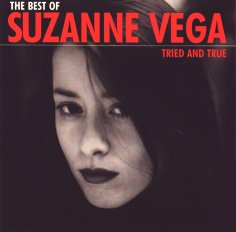
The long-overdue retrospective of the 80s and 90s most accomplished and consistently outstanding artist appeared in late 1998, finally bringing together some of her finest work on one CD. At just under an hour, it’s perhaps a little on the short side for a Best Of, and trying to condense her career into 15 tracks (with room for 2 brand new songs) will inevitably mean some omissions, but overall it gives a good account of the wonderful and varied styles encompassed on her 5 studio albums.
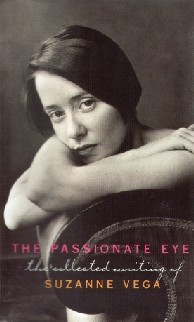
“THE PASSIONATE EYE”
The Collected Writing Of Suzanne Vega
Anyone with only a passing interest or knowledge of the singer-songwriter would probably not expect to find what is contained within these pages. For too long she was dismissed as some kind of “folkie“, “wallflower“, and “intellectual” with an air of aloofness that – so people thought – betrayed a lack of passion or humour.
Well, her 1992 album “99.9 Degrees Fahrenheit” finally laid most of those preconceptions to waste, the inherent ambiguity and mystery of her lyrics backed up with a striking musical canvas and an undercurrent of something distinctly awry. It was as though everything she had done up until that point was merely testing the waters…both of in terms of what reactions she might receive from the public, and also of her own artistry and muse.
The central section of this stylish book is taken up with a lengthy and fascinating conversation between Leonard Cohen (assuming the role of interviewer) and Vega (the interviewee). It took place at the time of 99.9F’s launch, and gives a telling insight to where she is coming from as an artist as well as the background to that album.
Elsewhere, the pages are split up into thematic sections (of sorts), with selections of song lyrics (some available on album and some still-unreleased), poems from her childhood and teenage years, and miscellaneous observations and commentaries upon the aspects of life and human nature that infuse her work and appear to recur at regular intervals in different guises.
It’s a perfect format for bringing the best out of Vega’s writing, the grouped texts encapsulating the various themes touched upon over her 15-year recording career in such a way as to shed new perspective and light on the most familiar of songs.
Intruigingly, the book opens with a explanation of fightning techniques used during her formative years in a New York neighbourhood. Tales of scraps with classmates at school, and a glimpse into a world that – to the casual observer – would appear most un-Vega like. Perhaps that is the intention…..as an opening declaration of “this is who I am, where I come from….drop your preconceived ideas about me NOW.”
Several on-stage monologues from her history of live performances are also incorporated, reaffirming the impression of a gifted storyteller. Having experienced this at first hand during the Solitude Standing tour of 1987, it comes as no surprise.
As a testament to her achievements and talents, The Passionate Eye suceeds without question, yet it is also a celebration of language that can be appreciated be anyone, even those not necessarily enamoured with the musical side of her – or indeed any other artists’ – work.
Review copyright © Jason Maloney, 2000. E-mail Jason Maloney
Check out Jason’s homepage: The Slipstream.
Reviewer of movies, videogames and music since 1994. Aortic valve operation survivor from the same year. Running DVDfever.co.uk since 2000. Nobel Peace Prize winner 2021.
